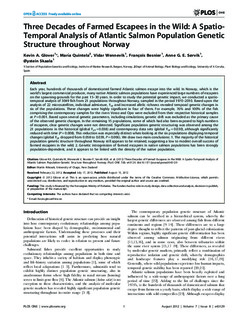| dc.description.abstract | Each year, hundreds of thousands of domesticated farmed Atlantic salmon escape into the wild. In Norway, which is the
world’s largest commercial producer, many native Atlantic salmon populations have experienced large numbers of escapees
on the spawning grounds for the past 15–30 years. In order to study the potential genetic impact, we conducted a spatiotemporal
analysis of 3049 fish from 21 populations throughout Norway, sampled in the period 1970–2010. Based upon the
analysis of 22 microsatellites, individual admixture, FST and increased allelic richness revealed temporal genetic changes in
six of the populations. These changes were highly significant in four of them. For example, 76% and 100% of the fish
comprising the contemporary samples for the rivers Vosso and Opo were excluded from their respective historical samples
at P = 0.001. Based upon several genetic parameters, including simulations, genetic drift was excluded as the primary cause
of the observed genetic changes. In the remaining 15 populations, some of which had also been exposed to high numbers
of escapees, clear genetic changes were not detected. Significant population genetic structuring was observed among the
21 populations in the historical (global FST = 0.038) and contemporary data sets (global FST = 0.030), although significantly
reduced with time (P = 0.008). This reduction was especially distinct when looking at the six populations displaying temporal
changes (global FST dropped from 0.058 to 0.039, P = 0.006). We draw two main conclusions: 1. The majority of the historical
population genetic structure throughout Norway still appears to be retained, suggesting a low to modest overall success of
farmed escapees in the wild; 2. Genetic introgression of farmed escapees in native salmon populations has been strongly
population-dependent, and it appears to be linked with the density of the native population. | no_NO |
